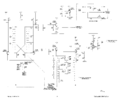507: Difference between revisions
No edit summary |
No edit summary |
||
| Line 20: | Line 20: | ||
* [http://w140.com/thomas_and_hearst-measurement_of_exploding_wire_energy.pdf Thomas and Hearst, "An Electronic Scheme for Measurement of Exploding Wire Energy"] | * [http://w140.com/thomas_and_hearst-measurement_of_exploding_wire_energy.pdf Thomas and Hearst, "An Electronic Scheme for Measurement of Exploding Wire Energy"] | ||
<gallery> | <gallery> | ||
Image:Tek 507.jpg | Image:Tek 507.jpg|507 on Cart | ||
Image:Tek 507 and ps.jpg | Image:Tek 507 and ps.jpg|507 with Power Supply | ||
Image:Tek 507 at general electric.jpg | Image:Tek 507 at general electric.jpg|507 at General Electric | ||
File:Tek 507 block diagram.png|Block Diagram | |||
File:Tek 507 sweep trigger and trip pulse.png|Sweep Trigger and Trip Pulse | |||
File:Tek 507 time mark generator.png|Time Mark Generator | |||
File:Tek 507 vertical deflection.png|Vertical Deflection | |||
File:Tek 507 horizontal amp.png|Horizontal Amplifier | |||
File:Tek 507 crt circuit.png|CRT Circuit | |||
File:Tek_507_heater_wiring.png|Heater Wiring | |||
File:Tek 507 power supply.png|Power Supply | |||
</gallery> | </gallery> | ||
Revision as of 05:47, 30 May 2014
The Tektronix Type 507 was designed for the power industry for surge testing. It was introduced in 1959. The scope was intended to operate in an environment of strong electromagnetic fields. It does not take plug-ins. The power supply is external, like the 517, 551, and 555.
The vertical signal path of the 507 does not contain amplifiers. It has a 5 nanosecond risetime. The input impedance of the 507 is 72 ohms. The maximum sensitivity is deliberately low: 50V/cm. The input attenuator is very unusual for Tek scopes. It is a switch with ten positions in "% of signal", where each step is 10%. The deflection signal is permanently AC-coupled and, unusually, the DC blocking capacitor is after the input attenuator.
The 507 has 20kV of post-deflection acceleration, produced by four 1X2 tubes. The lower-voltage power supplies, located in the external box, are all tube except for selenium rectifiers for some of the lower voltages.
- Tektronix 507 Manual (PDF)
- W. D. Bunting, "A Reliable Spark Gap For Capacitor Bank Switching"
- Thomas and Hearst, "An Electronic Scheme for Measurement of Exploding Wire Energy"
-
507 on Cart
-
507 with Power Supply
-
507 at General Electric
-
Block Diagram
-
Sweep Trigger and Trip Pulse
-
Time Mark Generator
-
Vertical Deflection
-
Horizontal Amplifier
-
CRT Circuit
-
Heater Wiring
-
Power Supply










